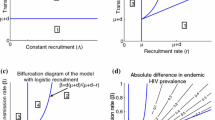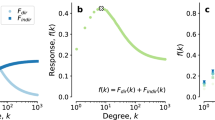Abstract
Mathematical models have been used to simulate HIV transmission and to study the use of preexposure prophylaxis (PrEP) for HIV prevention. Often a single intervention outcome over 10 years has been used to evaluate the effectiveness of PrEP interventions. However, different metrics express a wide variation over time and often disagree in their forecast on the success of the intervention. We develop a deterministic mathematical model of HIV transmission and use it to evaluate the public-health impact of oral PrEP interventions. We study PrEP effectiveness with respect to different evaluation methods and analyze its dynamics over time. We compare four traditional indicators, based on cumulative number or fractions of infections prevented, on reduction in HIV prevalence or incidence and propose two additional methods, which estimate the burden of the epidemic to the public-health system. We investigate the short and long term behavior of these indicators and the effects of key parameters on the expected benefits from PrEP use. Our findings suggest that public-health officials considering adopting PrEP in HIV prevention programs can make better informed decisions by employing a set of complementing quantitative metrics.









Similar content being viewed by others
References
Abbas, U. L., Anderson, R. M., & Mellors, J. W. (2007). Potential impact of antiretroviral chemoprophylaxis on HIV-1 transmission in resource-limited settings. PLoS ONE, 2, e875.
AIDS epidemic update: November 2009. UNAIDS/WHO, 2009. http://data.unaids.org/pub/report/2009/jc1700_epi_update_2009_en.pdf.
Alsallaq, R. A., Schiffer, J. T., Longini, I. M., Wald, A., Corey, L., & Abu-Raddad, L. J. (2010). Population level impact of an imperfect prophylactic vaccine for Herpes Simplex Virus-2. Sex. Transm. Dis., 37, 290–297.
Bhunu, C. P., Mushayabasa, S., & Tchuenche, J. M. (2011). A theoretical assessment of the effects of smoking on the transmission dynamics of tuberculosis. Bull. Math. Biol., 73, 1333–1357.
Blower, S. M., & Dowlatabadi, H. (1994). Sensitivity and uncertainty analysis of complex models of disease transmission: an HIV model, as an example. Int. Stat. Inst., 62, 229–243.
Blower, S. M., Koelle, K., Kirschner, D. E., & Mills, J. (2001). Live attenuated HIV vaccines: predicting the tradeoff between efficacy and safety. Proc. Natl. Acad. Sci. USA, 98, 3618–3623.
Boily, M. C., Baggaley, R. F., Wang, L., Masse, B., White, R. G., Hayes, R. J., & Alary, M. (2009). Heterosexual risk of HIV-1 infection per sexual act: systematic review and meta-analysis of observational studies. Lancet Infect. Dis., 9, 118–129.
Desai, K., Sansom, S. L., Ackers, M. L., Stewart, S. R., Hall, H. I., Hu, D. J., Sanders, R., Scotton, C. R., Soorapanth, S., Boily, M. C., Garnett, G. P., & McElroy, P. D. (2008). Modeling the impact of HIV chemoprophylaxis among men who have sex with men in the United States: infections prevented and cost-effectiveness. AIDS, 22, 1829–1839.
Dimitrov, D. T., Masse, B., & Boily, M. C. (2010). Who will benefit from a wide-scale introduction of vaginal microbicides in developing countries? Stat. Commun. Infect. Dis., 2(1), 4.
Dimitrov, D. T., Boily, M. C., Baggaley, R. F., & Masse, B. (2011). Modeling the gender-specific impact of vaginal microbicides on HIV transmission. J. Theor. Biol., 288, 9–20.
Dimitrov, D. T., Masse, B. R., & Marie-Claude, B. (2013). Beating the placebo in HIV prevention efficacy trials: the role of the minimal efficacy bound. J. Acquir. Immune Defic. Syndr., 62(1), 95–101. doi:10.1097/QAI.0b013e3182785638
Eisingerich, A. B., Wheelock, A., Gomez, G. B., Garnett, G. P., Dybul, M. R., & Piot, P. K. (2012). Attitudes and acceptance of oral and parenteral HIV preexposure prophylaxis among potential user groups: a multinational study. PLoS ONE, 7, e28238.
Foss, A. M., Vickerman, P. T., Heise, L., & Watts, C. H. (2003). Shifts in condom use following microbicide introduction: should we be concerned? AIDS, 17, 1227–1237.
Grant, R. M., Lama, J. R., Anderson, P. L., et al. (2010). Preexposure chemoprophylaxis for HIV prevention in men who have sex with men. N. Engl. J. Med., 363, 2587–2599.
Greene, E., Batona, G., Hallad, J., Johnson, S., Neema, S., & Tolley, F. (2010). Acceptability and adherence of a candidate microbicide gel among high-risk women in Africa and India. Cult. Heatlh Sex., 2(7), 739–754.
Hallett, T. B., Alsallaq, R. A., Baeten, J. M., Weiss, H., Celum, C., Gray, R., & Abu-Raddad, L. (2011). Will circumcision provide even more protection from HIV to women and men? New estimates of the population impact of circumcision interventions. Sex. Transm. Infect., 87, 88–93.
Kalichman, S. C., Simbayi, L. C., Cain, D., & Jooste, S. (2009). Heterosexual anal intercourse among community and clinical settings in Cape Town, South Africa. Sex. Transm. Infect., 85, 411–415.
Karim, Q. A., Karim, S. S. A., Frohlich, J. A., Grobler, A. C., Baxter, C., Mansoor, L. E., Kharsany, A. B. M., Sibeko, S., Mlisana, K. P., Omar, Z., Gengiah, T. N., Maarschalk, S., Arulappan, N., Mlotshwa, M., Morris, L., Taylor, D., & and on behalf of the CAPRISA 004 Trial Group (2010). Effectiveness and safety of tenofovir gel, an antiretroviral microbicide, for the prevention of HIV infection in women. Science, 329, 1168–1174.
Mid-year population estimates 2011. Statistics South Africa http://www.statssa.gov.za/publications/P0302/P03022011.pdf
Morgan, D., Mahe, C., Mayanja, B., Okongo, J. M., Lubega, R., & Whitworth, J. A. G. (2002). HIV-1 infection in rural Africa: is there a difference in median time to AIDS and survival compared with that in industrialized countries? AIDS, 16, 597–603.
Mtisi, E., Rwezaura, H., & Tchuenche, J. M. (2009). A mathematical analysis of malaria and tuberculosis co-dynamics. Discrete Contin. Dyn. Syst., Ser. A, 12, 827–864.
Mubayi, A., Zaleta, C. K., Martcheva, M., & Castillo-Chavez, C. (2010). A cost-based comparison of quarantine strategies for new emerging diseases. Math. Biosci. Eng., 7, 687–717.
Mubayi, A., Greenwood, P., Wang, X. H., Castillo-Chavez, C., Gorman, D. M., Gruenewald, P., & Saltz, R. F. (2011). Types of drinkers and drinking settings: an application of a mathematical model. Addiction, 106, 749–758.
Mwasa, A., & Tchuenche, J. M. (2011). Mathematical analysis of a cholera model with public health interventions. Biosystems, 105, 190–200.
Partners PrEP Study Team (2011). Pivotal study finds that HIV medications are highly effective as prophylaxis against HIV infection in men and women in Africa. Press Release 2011. http://depts.washington.edu/uwicrc/research/studies/files/PrEP_PressRelease-UW_13Jul2011.pdf
Porter, K., & Zaba, B. (2004). The empirical evidence for the impact of HIV on adult mortality in the developing world: data from serological studies. AIDS, 18, S9–S17.
Pretorius, C., Stover, J., Bollinger, L., Bacaer, N., & Williams, B. (2010). Evaluating the cost-effectiveness of pre-exposure prophylaxis (PrEP) and its impact on HIV-1 transmission in South Africa. PLoS ONE, 5, e13646.
Supervie, V., Garcia-Lerma, J. G., Heneine, W., & Blower, S. (2010). HIV, transmitted drug resistance, and the paradox of preexposure prophylaxis. Proc. Natl. Acad. Sci. USA, 107, 12381–12386.
Vissers, D. C. J., Voeten, H. A. C. M., Nagelkerke, N. J. D., Habbema, J. D. F, & de Vlas, S. J. (2008). The impact of pre-exposure prophylaxis (PrEP) on HIV epidemics in Africa and India: a simulation study. PLoS ONE, 3, e2077.
Wawer, M. J., Gray, R. H., Sewankambo, N. K., Serwadda, D., Li, X. B., Laeyendecker, O., Kiwanuka, N., Kigozi, G., Kiddugavu, M., Lutalo, T., Nalugoda, F., Wabwire-Mangen, F., Meehan, M. P., & Quinn, T. C. (2005). Rates of HIV-1 transmission per coital act, by stage of HIV-1 infection, in Rakai, Uganda. J. Infect. Dis., 191, 1403–1409.
Wilson, D. P., Coplan, P. M., Wainberg, M. A., & Blower, S. M. (2008). The paradoxical effects of using antiretroviral-based microbicides to control HIV epidemics. Proc. Natl. Acad. Sci. USA, 105, 9835–9840.
World Health Organization (WHO) (2003). Making choices in health: WHO guide to cost effectiveness analysis. Geneva: World Health Organization. http://whqlibdoc.who.int/publications/2003/9241546018.pdf.
Acknowledgements
D.D. is supported by a grant from the National Institutes of Health (Grant number 5 U01 AI068615-03). Y.Z., H.L., and Y.K. are supported in part by DMS-0920744.
The authors thank the anonymous referees for many useful comments on an earlier draft.
Author information
Authors and Affiliations
Corresponding author
Appendix
Appendix
1.1 A.1 Approximations of the Indicators at the Start of the Intervention
Based on the initial conditions for the two models, we can obtain the approximate behavior of the indicator at the start of the intervention. To facilitate this, we let I T (0)=I(0)+I p(0) and S T (0)=S(0)+S p(0). Recall that N(0)=S(0)+I(0) when there is no PrEP user and N(0)=S(0)+S p(0)+I(0)+I p(0) when there are PrEP users.
As examples, we will provide the approximation computation for the prevalence indicator, cumulative indicator, and fractional indicator. Recall that \(P_{I}= 1-\frac{[\frac{I^{p}+I}{S^{p}+S+I^{p}+I}]_{\mathrm{DP}}}{[\frac{I}{S+I}]}\). We will first estimate \([\frac{I}{S+I}]\) and \([\frac {I^{p}+I}{S^{p}+S+I^{p}+I}]_{\mathrm{DP}}\) separately:
Then by the expression of prevalence indicator, we have
Thus, the slope at which the prevalence indicator increases at the beginning of the intervention can be approximated by
By the expression of cumulative indicator, we have

Thus, the slope at which the cumulative indicator increases at the beginning of the intervention can be approximated by
By the expression of fractional indicator, we have

1.2 A.2 Asymptotic Approximations of the Indicators
To approximate the asymptotic behavior of indicators, we need to study the steady state of the two models. What is challenging is to study the steady state of the baseline model using PrEP (4). From
we obtain that at steady state
From
we obtain that at steady state,
Moreover, from
we obtain that at steady state,
In the following, let m=μ+d and \(\hat{I}=I^{p}+I\). Then at steady state,

Hence,
Let \(p=[\frac{I^{p}}{I^{p}+I}]_{\mathrm{DP}}=[\frac{I^{p}}{\hat{I}}]_{\mathrm{DP}}\), and assume that \(\hat{I}=I^{p}+I\neq0\) at steady state. Then
Notice that in the model with no intervention (6), the basic reproduction number is \(R_{0}=\frac{\beta}{\mu+d}\), and the endemic steady state is \((\frac{1}{\beta-d}\varLambda,\frac{R_{0}-1}{\beta-d}\varLambda )\). By the definitions of the indicators, now we can find the expressions to approximate the asymptotic behavior of \(\hat{C}_{I}\) and \(\hat{F}_{I}\):
Now consider the prevalence indicator, we want to find \([\frac{I^{p}+I}{S^{p}+S+I^{p}+I}]_{\mathrm{DP}}\) at the steady state.
Hence,
By the definition of prevalence indicator, the asymptotical behavior of the prevalence indicator can be determined by
For the cumulative indicator at the steady state, we have
We see that the cumulative indicator keeps increasing, and eventually the rate approaches a constant.
Finally, we look at the annual incidence indicator
then at steady state, we have
Rights and permissions
About this article
Cite this article
Zhao, Y., Dimitrov, D.T., Liu, H. et al. Mathematical Insights in Evaluating State Dependent Effectiveness of HIV Prevention Interventions. Bull Math Biol 75, 649–675 (2013). https://doi.org/10.1007/s11538-013-9824-7
Received:
Accepted:
Published:
Issue Date:
DOI: https://doi.org/10.1007/s11538-013-9824-7




